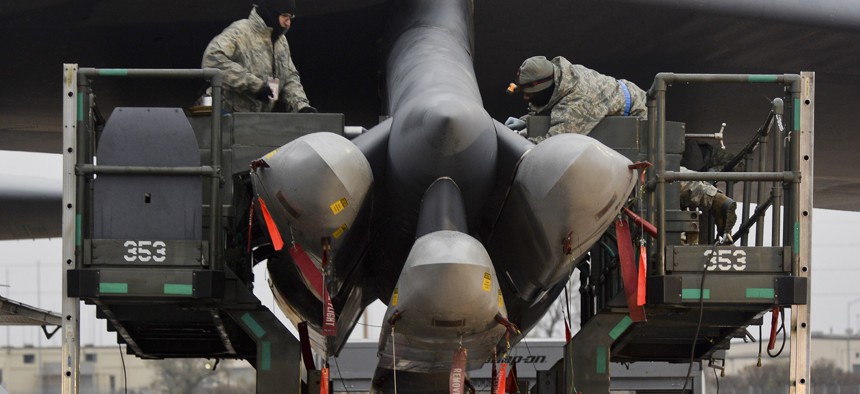
Airmen assigned to the 5th Aircraft Maintenance Squadron load AGM-86/B air-launched cruise missiles onto the wing of a B-52H Stratofortress at Minot Air Force Base, N.D., on Nov. 3, 2015. U.S. Air Force / Airman 1st Class J.T. Armstrong
Trump's NATO-Rattling Interview Has Delayed a Key Evolution in US Nuclear Posture
The Obama administration had been working to reassure nervous allies ahead of renouncing any first use of nuclear weapons. Now that's on hold.
Add to the wreckage of the Donald Trump campaign the receding likelihood that the Obama administration will declare that the sole purpose of U.S. nuclear weapons is to respond to nuclear attacks.
Such a declaration of “No First Use” makes sense for the United States. A first use of nuclear weapons is not a realistic option for an American president. Even Trump has virtually said as much – that he would be very slow to pull the nuclear trigger. But he has also talked about pulling back from U.S. treaty obligations to respond to attacks on NATO allies by conventional or sub-conventional means. This, on top of Vladimir Putin’s annexation of Crimea and Russian salami-slicing elsewhere around its periphery, makes it a bad time to change a bad nuclear posture.
The current U.S. stance is a relic of the Cold War, when extreme measures were deemed necessary for credible deterrence. The first-use option was a way to bolster the defense of America’s European allies in the face of numerically superior conventional forces of the Warsaw Pact. Even then, questions lingered. If tens of thousands of U.S. troops backed by thousands of nuclear weapons would not deter Moscow, would the U.S. threat of first use tip the scales? After the Soviet Union dissolved, investigators discovered that its military plans called for the first use of nuclear weapons along with a conventional blitzkrieg. In hindsight, two first-use postures were even more dangerous than one.
Today, the United States enjoys significant conventional military advantages, yet it retains the option of first use. The case for doing so now rests on localized military contingencies in the Baltics, against China, or on the Korean peninsula, where it might deter the use of nuclear, chemical and biological weapons by a leader like North Korea’s Kim Jong-il. The posture’s biggest backers are new NATO members who worry the most about Russian bellicosity.
But nuclear first use is not the answer to these contingencies. Nuclear deterrence works best in the abstract. It relies on ambiguity and uncertainty. The belief system built around nuclear deterrence implodes once the first mushroom cloud appears, and one nuclear detonation is very likely to lead to the next. U.S. allies enjoy being under the nuclear umbrella, but they do not want to be defended with nuclear detonations on their soil.
An American president who decides to be the first since Hiroshima and Nagasaki to cross the nuclear threshold, regardless of the provocation, would be widely reviled as the most dangerous person in the world. Presidents would do everything in their power to avoid this, which makes a first-use posture a hollow threat, no more than a psychological crutch. Russia, Pakistan and North Korea might need this psychological crutch; the United States doesn’t. U.S. allies would be better off if weaned from it.
Doing away with the fiction of first use would also reduce the salience of nuclear weapons in U.S. defense strategy and make it even harder for others to cross this threshold first. Adopting No First Use can help allies focus on a reality-based extended deterrent based on forward-deployed and rotational troop deployments, theater missile defenses, port calls, flyovers by U.S. bombers and fighters capable of delivering nuclear weapons, and multinational training exercises – backed up by thousands of nuclear weapons, including some based in Europe.
The United States is taking these steps. The Congress will spend huge sums to replace aging nuclear-armed bombers, missiles, and submarines. NATO is standing up new battalions for the Baltic states and Poland. Upgrades in theater missile defenses are being readied for Europe and Asia. Allies who think this is insufficient, and that the first use of a nuclear weapon remains crucial, are beholden to do more for the common defense. If they don’t, then the first-use option is worse than a psychological crutch – it’s an enabling device for slackers.
At some point, the leader of the most powerful nation in the world will have the wisdom to announce that the sole purpose of U.S. nuclear weapons is to retaliate against their use by others. Sadly, Donald Trump’s rash words about a loosening commitment to NATO have made it harder to let go of a first-use posture – for now.



